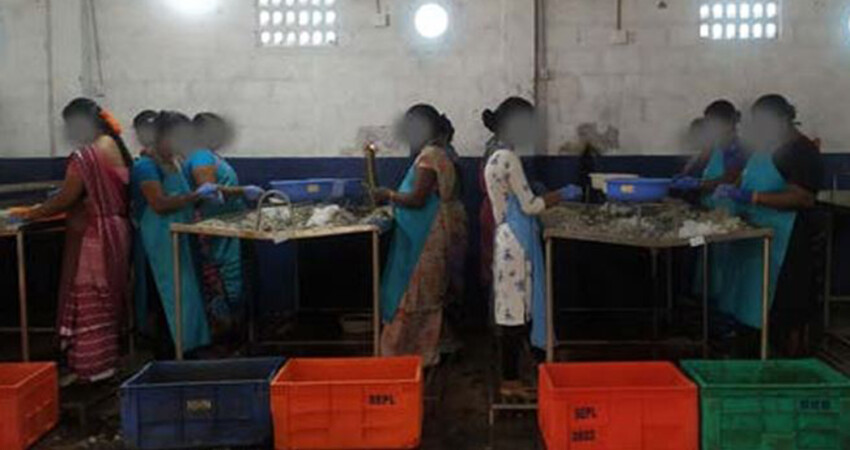The Southern Shrimp Alliance (SSA) has issued a formal request that Indian shrimp be added to the U.S. Department of Labor’s 2024 List of Goods Produced by Child Labor or Forced Labor.
The list is released annually, though the 2023 report has still not been issued. In the 2022 report, Taiwan, Thailand, China, Bangladesh, and Myanmar were called out for the alleged use of forced labor in their fishing or shrimp-processing sectors. In the 2020 report, Brazil, Cambodia, El Salvador, Kenya, Nicaragua, Paraguay, Peru, the Philippines, Tanzania, Uganda, Vietnam, and Yemen were cited as having child labor present in their seafood industries, while countries listed as having forced labor in their seafood sectors included China, Taiwan, Thailand, Bangladesh, Ghana, and Indonesia.
The SSA, which represents the U.S. domestic shrimp sector, sent a letter to the U.S. Department of Labor’s Bureau of International Labor Affairs on 25 March, citing evidence presented in recent reports from the Corporate Accountability Lab, the Associated Press, and The Outlaw Ocean Project, each of which investigated the Indian shrimp industry.
“These various reports and disclosures document both child and forced labor practices in the Indian shrimp industry,” the SSA wrote. “The Trafficking Victims Protection Reauthorization Act mandates that the U.S. Department of Labor publish a list of goods that ILAB has ‘reason to believe’ are produced using forced or child labor in violation of international standards. For the purposes of the next scheduled update of the List of Goods Produced by Child Labor or Forced Labor in 2024, the Southern Shrimp Alliance requests that ILAB find that there is sufficient evidence to include shrimp produced in India in the 2024 List of Goods Report as a good produced through child and forced labor and, further, immediately include shrimp from India on ILAB’s List of Products Produced by Forced or Indentured Child Labor.”
The letter, signed by SSA Executive Director John Williams, alleged that even as India’s share of the U.S. shrimp market has grown over the past decade, reaching nearly 40 percent in 2023, its shrimp industry continues to rely on manual labor rather than automation, particularly for peeling shrimp. In order to keep costs down, India’s shrimp industry has become increasingly reliant on unregistered shrimp farms and peeling sheds “that operate in the shadows behind what the industry shows the public.”
The SSA cited the findings of a 2022 investigation of the Indian shrimp industry by environmental assurance and verification service ELEVATE that found evidence of workers in the Indian shrimp industry being held against their will, forced to work overtime and excessive hours without pay, and subject to debt bondage.
The SSA also cited a section of the CAL report to demonstrate evidence of child labor in India’s shrimp sector.
“One peeling shed in East Godavari in Andhra Pradesh, locally referred to as the Police Raju shed, is well-known for using children in its shrimp-processing operations. Even the supervisor at the shed confirmed that the children, whose parents are migrant workers from West Bengal, work full time peeling shrimp and do not attend school,” the SSA said. “According to a worker at a nearby peeling shed, ‘The migrant workers get on the workstation as pairs. One cleans, while the kids do the cutting. Young children also work at his shed.’ CAL’s field investigators verified that several children – some of whom looked to be as young as 12 – worked at the Police Raju peeling shed.”
ILAB said it maintains the list “primarily to raise public awareness about forced labor and child labor around the world and to promote efforts to combat them; it is not intended to be punitive but rather to serve as a catalyst for more strategic and focused coordination and collaboration among those working to address these problems.”
Nonetheless, Williams said India should be added to its list to send a message that forced labor or child labor is not tolerated by the U.S. government.
“As importers have continued to profit from the widespread suffering caused by exploitation in India’s shrimp industry, the Southern Shrimp Alliance believes that the federal government must act,” Williams wrote. “By including Indian shrimp in the upcoming list, the agency would not only highlight the systemic issues of labor exploitation in the Indian shrimp industry but also demonstrate a commitment to combating child labor and forced labor worldwide.”
The Southern Shrimp Alliance has aggressively pursued action by the federal government to limit the entrance of imported shrimp to the U.S., claiming it is not produced on a level playing field as domestic products. Williams said this was the first time the organization had asked ILAB to add a product to the agency’s List of Products Produced by Forced or Indentured Child Labor.
“Enough is enough,” Williams said. “ILAB’s reports already recognize that no country in the world presents a greater risk of child and forced labor than India. It is well past time for the federal government to recognize what is obvious to everyone who looks; the ‘Product of India’ label on bags of shrimp in your local grocery store is a mark of unimaginable human suffering.”
This story originally appeared on SeafoodSource.com and has been republished here with permission.







